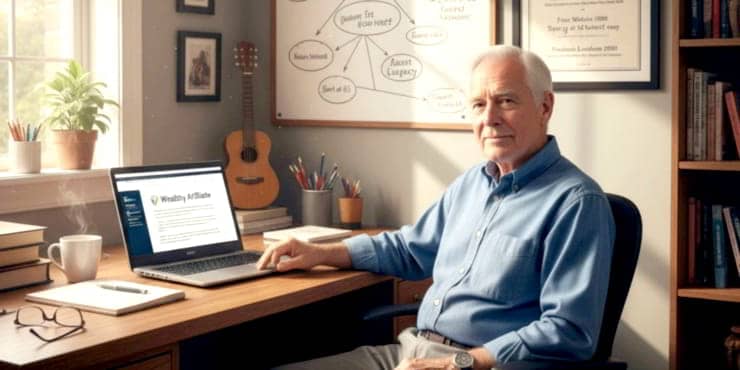How To Achieve Big Goals: Philosophy of ‘Make Big Plans, Build Small Habits’

Estimated reading time: 9 Min
Here is how to achieve big goals by combining ambitious thinking with realistic actions then making incremental progress as the key to long-term success.
We all dream big.
Whether it’s launching a successful business, mastering a new skill, or achieving personal milestones, the ambition to aim high is inherent in us.
But how do we transform these grand aspirations into reality?
The answer lies in the philosophy of ‘Make Big Plans, Build Small Habits’.
It’s about dreaming big but starting small; chunking down large visions into small, achievable steps.
What Does ‘Think Big’ Really Mean?
Thinking big means setting audacious goals that inspire and challenge you.
It’s about envisioning a future that’s significantly better than the present.
This kind of thinking fuels personal and professional growth by pushing boundaries and expanding possibilities.
While some might see big thinking as impractical or daunting, it’s important to understand that big dreams provide a sense of direction and purpose.
A strong commitment to achieving a big dream acts as a motivational force that drives you forward, even when the path seems difficult.
The Psychological Benefits of Big Thinking
When you set large aspirations, you stimulate your mind to think beyond immediate limitations.
This activates the brain’s creative centres, encouraging innovative solutions and outside-of-the-box thinking.
Psychologically, committed big goals can boost your self-esteem and increase your resilience.
You start to see challenges as opportunities rather than obstacles, which shifts your perspective and opens up new possibilities.
Debunking Myths About Big Thinking

There are several misconceptions about big thinking.
- Some believe that thinking big is only for the bold or the risk-takers, but in reality, anyone can cultivate this mindset.
- Another myth is that big thinking leads to disappointment if goals are not achieved.
However, the journey towards these goals, filled with learning and growth, is valuable in itself.
Finally, some assume that big thinkers disregard practicalities, but the most successful big thinkers combine their visions with practical, achievable steps.
Understanding Consistent Small Actions
What exactly is a ‘small action’?
It’s a manageable task or habit that, when performed consistently, leads to significant progress over time.
These small actions are the building blocks of larger achievements.
While big steps (and efforts) might seem appealing, they are often unsustainable.
In contrast, consistent small steps create a steady momentum that compounds over time, leading to substantial results.
The tortoise truly does win the race when it comes to both personal and professional development.
The Role of Consistency in Building Momentum
Consistency is the key to making small actions effective.
By repeating a small task daily or at least regularly, you build momentum and create a positive cycle of effort.
This consistency helps establish functional routines, making it easier to maintain progress even when motivation is low.
For example, writing 500 words a day can seem insignificant, but over a year, it results in a substantial manuscript.
This cumulative effect demonstrates the power of small, consistent actions.
Comparing Large Efforts vs. Continuous Small Steps
Periodic large efforts often lead to the experience of burnout and inconsistency.
They can be overwhelming and difficult to sustain.
On the other hand, continuous small steps are more manageable and less intimidating.
They allow for steady progress and adaptability.
Imagine trying to exercise for three hours once a week versus 30 minutes daily.
The latter is more sustainable and integrates seamlessly into your routine, leading to better long-term health outcomes.
Why Small, Consistent Actions Work
The success of small, consistent actions is rooted in psychology.
When you commit to a small habit daily, it gradually becomes part of your routine, reducing the mental effort required.
This stimulates a growth mindset, as each small success builds confidence and motivation.
Consider the stories of successful individuals like James Clear, author of ‘Atomic Habits’, who emphasise the power of tiny, incremental changes.
These small wins accumulate, creating a ripple effect that propels you toward your larger goals.
A Daily Commitment: The 1% Improvement Strategy
The idea of improving by just 1% every day is well known, and not a cliché; it’s simple yet powerful.
This strategy, popularised by British cycling coach Dave Brailsford, involves making tiny adjustments that lead to significant improvements over time.
To implement this in your life, start by identifying areas where you can make minor enhancements.
Track your progress meticulously and celebrate small victories.
This not only boosts your motivation but also helps maintain a positive outlook on your journey towards bigger achievements.
Expanding Your Mindset for Greater Achievement
Your mindset plays a crucial role in achieving your long-term objectives.
A positive, growth-oriented mindset enables you to see challenges as opportunities, and setbacks as learning experiences.
Techniques like visualisation, affirmations, and mindfulness can help cultivate this mindset.
Being aware of progress and flexible are also vital skills, as they allow you to adapt to changing circumstances while staying focused on your big plans.
Balancing Big Plans with Small Steps
Idealistic visions and well-thought-through action steps must coexist harmoniously for success.
Strategic goal setting involves pairing lofty ambitions with manageable objectives.
For instance, if your goal is to write a book, start by writing a page a day.
This way, the overwhelming task of writing a book becomes a series of small, achievable steps.
Look at individuals like Elon Musk, who balances his ambitious vision for space travel with practical, incremental advances in technology.
Designing a Lifestyle Compatible with Your Aspirations
Creating and sustaining habits that align with your big plans requires a structured approach.
Begin by identifying habits that support your goals and design a routine that integrates them seamlessly into your daily life.
Tools like habit trackers can be incredibly helpful in monitoring your progress and ensuring development.
Consider the transformational impact of habit architecture on individuals like Michael Phelps, whose rigorous training routine led to Olympic success.
The Foundations of Habit Formation
Habit formation relies on the cue-routine-reward loop as follows:
Identify cues that trigger your habits, establish a routine that aligns with your goals, and ensure a reward that reinforces the behaviour.
This loop helps solidify habits and makes them more resistant to disruptions.
Using apps like Habitica or Streaks can aid in this process by providing a visual representation of your progress and maintaining accountability.
Case Studies: Real-Life Transformations Through Habit Architecture
Michael Phelps – Olympic Swimmer
Habit: Michael Phelps incorporated a meticulous and consistent training routine into his daily life. This included specific warm-up exercises, visualisation techniques, and swim practice.
Impact: His rigorous habit architecture helped him become the most decorated Olympian of all time, with 23 gold medals. Phelps’ daily habits ensured that he was always prepared, both mentally and physically, for competition.
Steve Jobs – Co-founder of Apple
Habit: Steve Jobs was known for his focus on simplicity and mindfulness. He practiced daily meditation, maintained a strict morning routine, and consistently engaged in deep, uninterrupted work sessions.
Impact: These habits helped Jobs foster creativity and innovation, leading to the development of ground breaking products like the iPhone and iPad. His disciplined approach to work and life played a crucial role in Apple’s success.
James Clear – Author of “Atomic Habits”
Habit: James Clear built his success on the principles he teaches. He focused on making 1% improvements every day, developing small, consistent habits in writing, exercise, and productivity.
Impact: Clear’s habit architecture not only transformed his personal life but also led to the creation of his bestselling book, “Atomic Habits,” which has helped millions of readers build better habits and achieve their goals.
Benjamin Franklin – Founding Father of the United States
Habit: Benjamin Franklin developed a daily schedule that emphasised personal development and productivity. He practiced virtues such as temperance, industry, and resolution, and kept a daily journal to reflect on his progress.
Impact: Franklin’s disciplined habits contributed to his success as a statesman, inventor, and writer. His habit architecture enabled him to achieve a wide range of accomplishments, from founding libraries to contributing to the drafting of the U.S. Constitution.
Serena Williams – Professional Tennis Player
Habit: Serena Williams follows a rigorous training regimen that includes physical workouts, mental conditioning, and strategic practice sessions. She also focuses on recovery and nutrition as part of her daily routine.
Impact: Williams’ dedication to her habits has made her one of the greatest tennis players of all time, with 23 Grand Slam singles titles. Her habit architecture supports her performance, resilience, and longevity in the sport.
FAQs: How To Achieve Big Goals
Why is it important to think big?
Thinking big sets a clear, ambitious direction for your efforts and motivates you to push beyond your comfort zone.
How can I identify effective small actions?
Look for tasks that are simple, repeatable, and align directly with your larger goals.
What if I struggle with consistency?
Start with very small, manageable habits and use tools like habit trackers to stay accountable.
How does the 1% improvement strategy work?
It involves making minor daily improvements that compound over time, leading to significant progress.
Can small habits really lead to big success?
Yes, small habits create a foundation for sustained progress and can lead to significant achievements over time.
What is meant by Habit Architecture”?
Habit architecture refers to the systematic approach of creating, maintaining, and optimising habits to align with your larger goals and aspirations. It’s about designing a lifestyle where your daily routines and behaviours naturally support your long-term objectives. Just like an architect plans and constructs a building with a clear blueprint, you can construct your habits deliberately and with precision.
What common elements are found in the habits of successful people?
Consistency, clear routines, and a focus on incremental improvements are common elements.
How do small daily habits lead to significant achievements?
Small daily habits compound over time, creating momentum and substantial progress towards larger goals.
Can habit architecture be applied in any field?
Yes, habit architecture is a versatile approach that can be tailored to any field or personal goal.
What tools can help me design my habit architecture?
Habit tracking apps, journals, and regular self-reflection can help in designing and maintaining effective habits.
How important is mindset in building effective habits?
A growth-oriented mindset is vital as it helps you view challenges as opportunities and stay committed to your habits.
Summary: Moulding Your Tomorrow, One Habit at a Time
The philosophy of ‘Make Big Plans, Build Small Habits’ is a powerful framework for achieving long-term success.
By embracing incremental growth and committing to daily habits, you can turn your grand visions into reality.
Remember, every big achievement starts with one small step.
Stay committed, keep progressing, and watch as your small habits pave the way to your biggest dreams.
Share how you get on by adding your story to the comments or use the contact form.
😉
Richard
Useful Resources
- Books:
- Atomic Habits by James Clear
- The Power of Habit by Charles Duhigg
- The 7 Habits of Highly Effective People by Stephen Covey
- Podcasts:
- The Tim Ferriss Show (Episode: “Tiny Changes, Remarkable Results” with James Clear)
- The Tony Robbins Podcast (Episode: “Change Your Habits, Change Your Life”)
- Optimal Living Daily (Episodes focused on habit formation and personal growth)
- Websites:
- James Clear – Articles and resources on habit formation
- Zen Habits – Blog by Leo Babauta on simplicity and habits
- Mind Tools – Resources on productivity and goal setting
- Apps:
- Habitica: Gamify your habit tracking.
- Streaks: Helps you build good habits by tracking your progress.



![Are Wealthy Affiliate Hubs Revolutionising Website & Content Development In [year]? A futuristic and sleek digital workspace designed for website management and content creation - Wealthy Affiliate Hubs](https://ml0yvzumdtic.i.optimole.com/cb:k6B_.1fa14/w:740/h:370/q:mauto/https://solobusinessmind.com/wp-content/uploads/2024/12/A-futuristic-and-sleek-digital-workspace-designed-for-website-management-and-content-creation-Wealthy-Affiliate-Hubs740x370-O.jpg)


